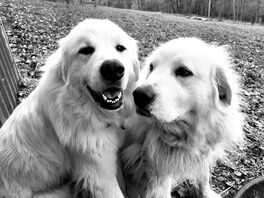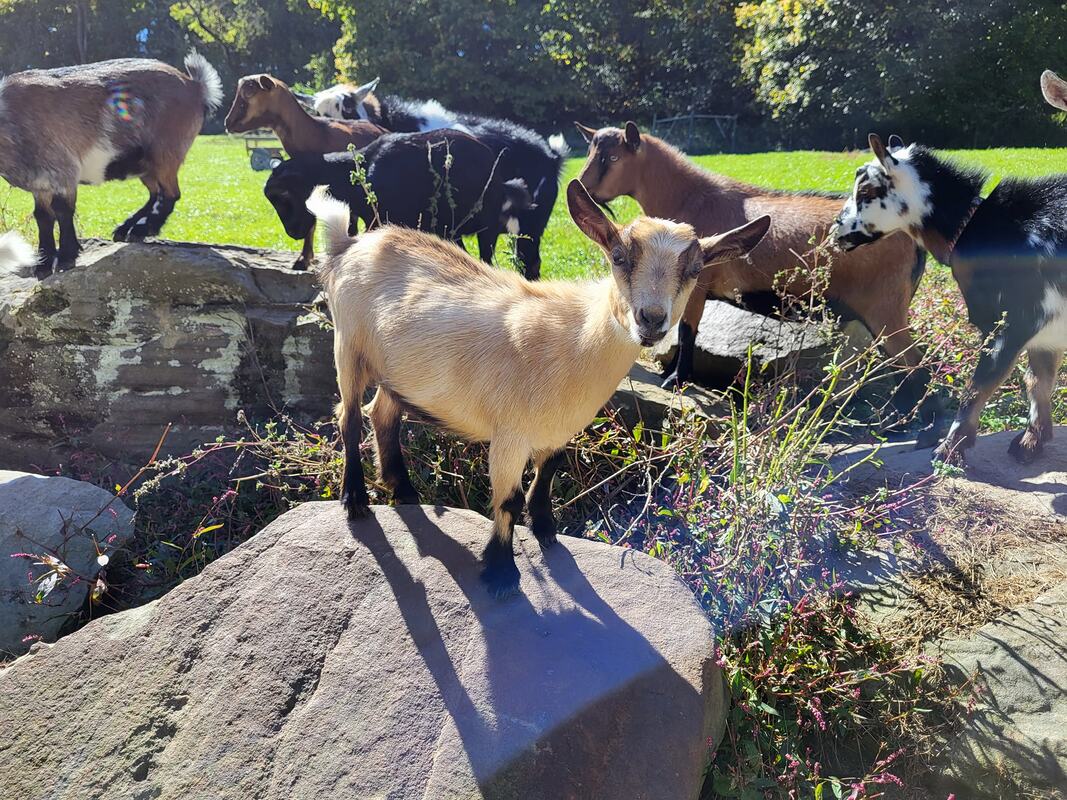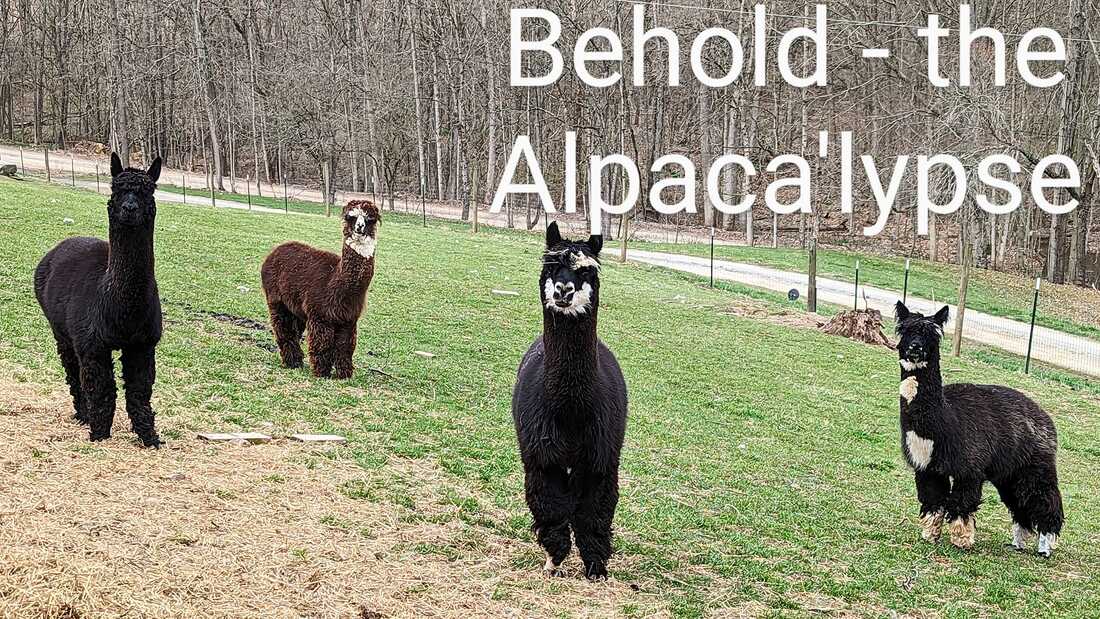 Luna & Sunny are littermate sisters we've had since they were 7 weeks old. Luna & Sunny are littermate sisters we've had since they were 7 weeks old. The main livestock pasture at Toby Way Farm features critters from three unique animal families. Canines (dogs), Caprines (goats), and Camelids (alpacas). Having all three of them living in one space poses some challenges and we’ve enjoyed getting to know each of these critters in depth to make it work! Here are some fun facts about our favorite farm friends: CANINES When choosing a livestock guardian breed we opted for a set of Great Pyrenees. We affectionately refer to our sister duo as the Polar Bears of Fresno. A well-established breed, Pyrs have been used as effective guard dogs for thousands of years. Originally they were used in the Pyrenees Mountains to protect livestock there from wolves and bears! Fossils have been found in the Pyrenees Mountains, indicating the breed has been serving shepherds there since at least 1800 BC. Experts believe the breed was likely developed from mountain dogs that originated in Asia Minor as many as 11,000 years ago! Unlike breeds known for highly assertive protection, the Pyrenees also nurtures the flock she protects with an instinct to be patient and kind with all vulnerable animals. When one of our newborn goats, still damp from birth, wandered away from her mama one cold March morning our Polar Bears accompanied the little rascal until help arrived, keeping the 3 lb baby warm and safe and even cleaning her off a little more. Pyrs are nocturnal by nature and they bark - a lot! Any sound that might even think about being a threat will be met with a loud alarm that may not be suitable for close neighbors. We have enjoyed watching our girls bond with their flock, and we rest easy knowing nothing dangerous is going to get close to our livestock! CAPRINES Part of the subfamily Caprinae, the goats we know and love today started out as wild critters in various middle eastern regions. It’s believed the Bezoar wild goat is the basis for all modern domestic goat varieties. Today goats are bred for several purposes: meat, milk, cart pulling, packing, fiber, and of course as beloved pets. We decided the Nigerian Dwarf would give us the best of several worlds. Small enough to be easily handled, producing a decent amount of milk for making soap and other dairy products, stout enough to be processed for meat, and fun enough to be sought after in the current goat market! Nigerian Dwarf mamas are generally easy kidders, rarely requiring assistance when giving birth even though those births could be up to SIX KIDS! ND’s supply a surprising amount of milk for their size - up to 2 quarts/day on average - but that still makes it tough on a mama to get enough groceries in her to feed high multiples. Breeders have to be prepared to bottle feed when supplementing is vital for healthy kid development. Milk from the Nigerian Dwarf is also very high in protein, and has the highest % of butterfat of all dairy goat breeds! Goat milk is naturally homogenized - meaning the cream will separate very little (if at all) from the rest of the milk if allowed to settle. You may notice that none of our goats are horned. They all are registered with the American Dairy Goat Association - an organization that requires any goats being shown must be dehorned. We also disbud for their own safety. In general, we believe nature knows best when it comes to critter anatomy, however keeping domesticated livestock means intervening in ways you might not expect. Some of our stock is naturally polled - they possess genes which keep them from growing horns. The rest are disbudded very early in life, using a process that is simple, effective, humane, and expertly performed by our local veterinarian. While we do keep some of the goats born on our farm, we sell most of the kids we breed to 4-H members and other dairy goat breeders, as well as families looking for pets. Watch our website for available kids and adults! www.tobywayfarm.weebly.com CAMELIDS The alpacas are a South American member of the Camelid family. Like goats, alpacas also started as wild critters but were domesticated by the Incas for their thick fiber. Today’s alpacas can be covered with two types of fleece: Suri alpacas have long silky dreadlocks. Huacaya alpacas - like the ones you see in our pasture - have dense shorter fleece that looks more like the wool on sheep. While related, alpacas are not llamas. Llamas are a larger cousin to the alpaca and cross breeding is possible (the resulting offspring are called huarizo) but they are 2 different critters. Llamas are larger and grow a shorter, more coarse fiber than alpacas. Alpacas tend to be more docile and easier to handle than llamas. We don’t have current plans to breed our alpacas - they’re all males and are intended to be pets and fiber growers only - but if we did the babies would be called “cria” and mamas would be pregnant with them for around 11 months! You may have heard that alpacas spit! It’s true, they’ll spit regurgitated food and saliva (translation: projectile vomit!) at one another when perturbed but rarely will they intentionally spit at a person (but it’s not out of the question!). Our boys are all intact males and registered with the Alpaca Owners Association. Although at times these boys get into brawls, males are actually known to be less aggressive and easier to handle than females. Each of our alpacas eats just 2 lbs of food per day! This makes them very efficient producers of fiber and fertilizer. Their soft feet also mean they are less detrimental to the soil and turf than cows would be. MORE FUN FACTS
Hopefully you’ve learned a little something about these critters that share our home with us. We think being educated about our livestock is vital to keeping healthy happy animals. Thanks for reading along! Becky
0 Comments
|
AuthorTucker (pomeranian) is an author of marginal famou'nicity. Catch his Tucker Tuesday farm pupdates here and on the Toby Way Farm facebook page. Archives
April 2023
Categories |



